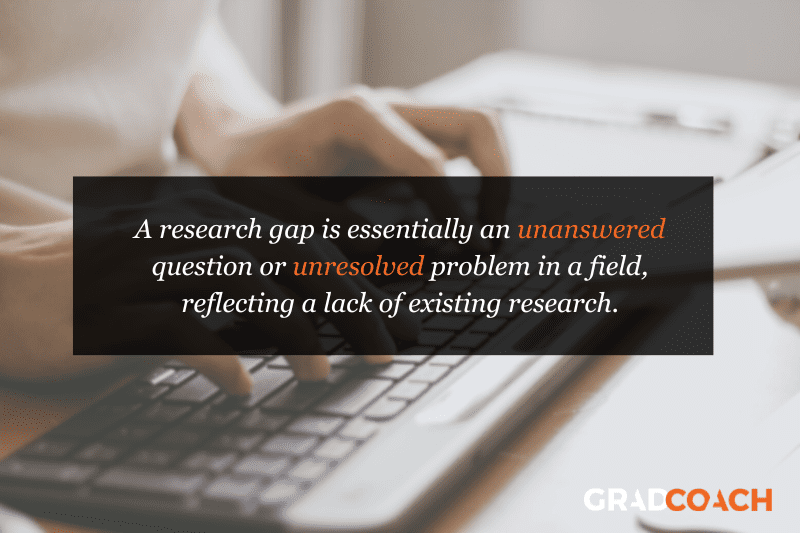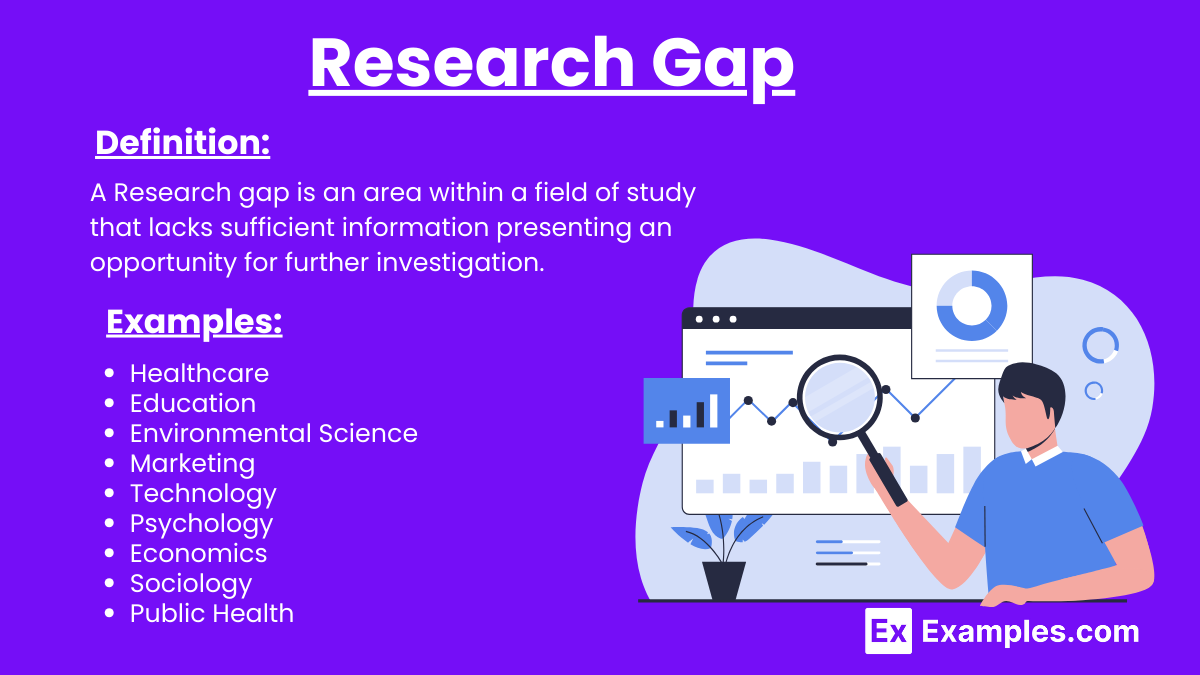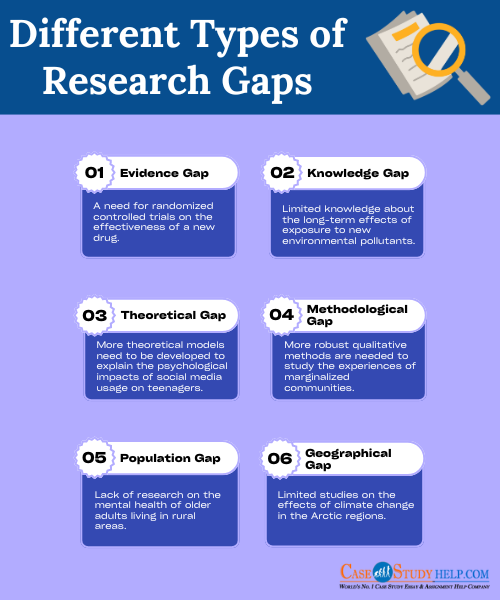
🚀 Work With Us
Private Coaching
Language Editing
Qualitative Coding
✨ Free Resources
Templates & Tools
Short Courses
Articles & Videos

The Research Gap (Literature Gap)

I f you’re just starting out in research, chances are you’ve heard about the elusive research gap (also called a literature gap). In this post, we’ll explore the tricky topic of research gaps. We’ll explain what a research gap is, look at the four most common types of research gaps, and unpack how you can go about finding a suitable research gap for your dissertation, thesis or research project.
Overview: Research Gap 101
- What is a research gap
- Four common types of research gaps
- Practical examples
- How to find research gaps
- Recap & key takeaways
What (exactly) is a research gap?
Well, at the simplest level, a research gap is essentially an unanswered question or unresolved problem in a field, which reflects a lack of existing research in that space. Alternatively, a research gap can also exist when there’s already a fair deal of existing research, but where the findings of the studies pull in different directions , making it difficult to draw firm conclusions.
For example, let’s say your research aims to identify the cause (or causes) of a particular disease. Upon reviewing the literature, you may find that there’s a body of research that points toward cigarette smoking as a key factor – but at the same time, a large body of research that finds no link between smoking and the disease. In that case, you may have something of a research gap that warrants further investigation.
Now that we’ve defined what a research gap is – an unanswered question or unresolved problem – let’s look at a few different types of research gaps.

Types of research gaps
While there are many different types of research gaps, the four most common ones we encounter when helping students at Grad Coach are as follows:
- The classic literature gap
- The disagreement gap
- The contextual gap, and
- The methodological gap
Need a helping hand?
1. The Classic Literature Gap
First up is the classic literature gap. This type of research gap emerges when there’s a new concept or phenomenon that hasn’t been studied much, or at all. For example, when a social media platform is launched, there’s an opportunity to explore its impacts on users, how it could be leveraged for marketing, its impact on society, and so on. The same applies for new technologies, new modes of communication, transportation, etc.
Classic literature gaps can present exciting research opportunities , but a drawback you need to be aware of is that with this type of research gap, you’ll be exploring completely new territory . This means you’ll have to draw on adjacent literature (that is, research in adjacent fields) to build your literature review, as there naturally won’t be very many existing studies that directly relate to the topic. While this is manageable, it can be challenging for first-time researchers, so be careful not to bite off more than you can chew.
⚡ GET THE FREE TEMPLATE ⚡
Fast-track your research with our award-winning Dissertation Template .
Download Now 📂
2. The Disagreement Gap
As the name suggests, the disagreement gap emerges when there are contrasting or contradictory findings in the existing research regarding a specific research question (or set of questions). The hypothetical example we looked at earlier regarding the causes of a disease reflects a disagreement gap.
Importantly, for this type of research gap, there needs to be a relatively balanced set of opposing findings . In other words, a situation where 95% of studies find one result and 5% find the opposite result wouldn’t quite constitute a disagreement in the literature. Of course, it’s hard to quantify exactly how much weight to give to each study, but you’ll need to at least show that the opposing findings aren’t simply a corner-case anomaly .

3. The Contextual Gap
The third type of research gap is the contextual gap. Simply put, a contextual gap exists when there’s already a decent body of existing research on a particular topic, but an absence of research in specific contexts .
For example, there could be a lack of research on:
- A specific population – perhaps a certain age group, gender or ethnicity
- A geographic area – for example, a city, country or region
- A certain time period – perhaps the bulk of the studies took place many years or even decades ago and the landscape has changed.
The contextual gap is a popular option for dissertations and theses, especially for first-time researchers, as it allows you to develop your research on a solid foundation of existing literature and potentially even use existing survey measures.
Importantly, if you’re gonna go this route, you need to ensure that there’s a plausible reason why you’d expect potential differences in the specific context you choose. If there’s no reason to expect different results between existing and new contexts, the research gap wouldn’t be well justified. So, make sure that you can clearly articulate why your chosen context is “different” from existing studies and why that might reasonably result in different findings.

4. The Methodological Gap
Last but not least, we have the methodological gap. As the name suggests, this type of research gap emerges as a result of the research methodology or design of existing studies. With this approach, you’d argue that the methodology of existing studies is lacking in some way , or that they’re missing a certain perspective.
For example, you might argue that the bulk of the existing research has taken a quantitative approach, and therefore there is a lack of rich insight and texture that a qualitative study could provide. Similarly, you might argue that existing studies have primarily taken a cross-sectional approach , and as a result, have only provided a snapshot view of the situation – whereas a longitudinal approach could help uncover how constructs or variables have evolved over time.

Practical Examples
Let’s take a look at some practical examples so that you can see how research gaps are typically expressed in written form. Keep in mind that these are just examples – not actual current gaps (we’ll show you how to find these a little later!).
Context: Healthcare
Despite extensive research on diabetes management, there’s a research gap in terms of understanding the effectiveness of digital health interventions in rural populations (compared to urban ones) within Eastern Europe.
Context: Environmental Science
While a wealth of research exists regarding plastic pollution in oceans, there is significantly less understanding of microplastic accumulation in freshwater ecosystems like rivers and lakes, particularly within Southern Africa.
Context: Education
While empirical research surrounding online learning has grown over the past five years, there remains a lack of comprehensive studies regarding the effectiveness of online learning for students with special educational needs.
As you can see in each of these examples, the author begins by clearly acknowledging the existing research and then proceeds to explain where the current area of lack (i.e., the research gap) exists.

How To Find A Research Gap
Now that you’ve got a clearer picture of the different types of research gaps, the next question is of course, “how do you find these research gaps?” .
Well, we cover the process of how to find original, high-value research gaps in a separate post . But, for now, I’ll share a basic two-step strategy here to help you find potential research gaps.
As a starting point, you should find as many literature reviews, systematic reviews and meta-analyses as you can, covering your area of interest. Additionally, you should dig into the most recent journal articles to wrap your head around the current state of knowledge. It’s also a good idea to look at recent dissertations and theses (especially doctoral-level ones). Dissertation databases such as ProQuest, EBSCO and Open Access are a goldmine for this sort of thing. Importantly, make sure that you’re looking at recent resources (ideally those published in the last year or two), or the gaps you find might have already been plugged by other researchers.
Once you’ve gathered a meaty collection of resources, the section that you really want to focus on is the one titled “ further research opportunities ” or “further research is needed”. In this section, the researchers will explicitly state where more studies are required – in other words, where potential research gaps may exist. You can also look at the “ limitations ” section of the studies, as this will often spur ideas for methodology-based research gaps.
By following this process, you’ll orient yourself with the current state of research , which will lay the foundation for you to identify potential research gaps. You can then start drawing up a shortlist of ideas and evaluating them as candidate topics . But remember, make sure you’re looking at recent articles – there’s no use going down a rabbit hole only to find that someone’s already filled the gap 🙂
Let’s Recap
We’ve covered a lot of ground in this post. Here are the key takeaways:
- A research gap is an unanswered question or unresolved problem in a field, which reflects a lack of existing research in that space.
- The four most common types of research gaps are the classic literature gap, the disagreement gap, the contextual gap and the methodological gap.
- To find potential research gaps, start by reviewing recent journal articles in your area of interest, paying particular attention to the FRIN section .
If you’re keen to learn more about research gaps and research topic ideation in general, be sure to check out the rest of the Grad Coach Blog . Alternatively, if you’re looking for 1-on-1 support with your dissertation, thesis or research project, be sure to check out our private coaching service .

You Might Also Like:

How To Choose A Tutor For Your Dissertation
Hiring the right tutor for your dissertation or thesis can make the difference between passing and failing. Here’s what you need to consider.

5 Signs You Need A Dissertation Helper
Discover the 5 signs that suggest you need a dissertation helper to get unstuck, finish your degree and get your life back.

Writing A Dissertation While Working: A How-To Guide
Struggling to balance your dissertation with a full-time job and family? Learn practical strategies to achieve success.

How To Review & Understand Academic Literature Quickly
Learn how to fast-track your literature review by reading with intention and clarity. Dr E and Amy Murdock explain how.

Dissertation Writing Services: Far Worse Than You Think
Thinking about using a dissertation or thesis writing service? You might want to reconsider that move. Here’s what you need to know.
📄 FREE TEMPLATES
Research Topic Ideation
Proposal Writing
Literature Review
Methodology & Analysis
Academic Writing
Referencing & Citing
Apps, Tools & Tricks
The Grad Coach Podcast
43 Comments
This post is REALLY more than useful, Thank you very very much
Very helpful specialy, for those who are new for writing a research! So thank you very much!!
I found it very helpful article. Thank you.
it very good but what need to be clear with the concept is when di we use research gap before we conduct aresearch or after we finished it ,or are we propose it to be solved or studied or to show that we are unable to cover so that we let it to be studied by other researchers ?
Just at the time when I needed it, really helpful.
Very helpful and well-explained. Thank you
VERY HELPFUL
We’re very grateful for your guidance, indeed we have been learning a lot from you , so thank you abundantly once again.
hello brother could you explain to me this question explain the gaps that researchers are coming up with ?
Am just starting to write my research paper. your publication is very helpful. Thanks so much
How to cite the author of this?
your explanation very help me for research paper. thank you
Very important presentation. Thanks.
Very helpful indeed
Best Ideas. Thank you.
I found it’s an excellent blog to get more insights about the Research Gap. I appreciate it!
Kindly explain to me how to generate good research objectives.
This is very helpful, thank you
How to tabulate research gap
Very helpful, thank you.
Thanks a lot for this great insight!
This is really helpful indeed!
This article is really helpfull in discussing how will we be able to define better a research problem of our interest. Thanks so much.
Reading this just in good time as i prepare the proposal for my PhD topic defense.
Very helpful Thanks a lot.
Thank you very much
This was very timely. Kudos
Great one! Thank you all.
Thank you very much.
This is so enlightening. Disagreement gap. Thanks for the insight.
How do I Cite this document please?
Research gap about career choice given me Example bro?
I found this information so relevant as I am embarking on a Masters Degree. Thank you for this eye opener. It make me feel I can work diligently and smart on my research proposal.
This is very helpful to beginners of research. You have good teaching strategy that use favorable language that limit everyone from being bored. Kudos!!!!!
This plat form is very useful under academic arena therefore im stil learning a lot of informations that will help to reduce the burden during development of my PhD thesis
This information is beneficial to me.
Insightful…
I have found this quite helpful. I will continue using gradcoach for research assistance
Doing research in PhD accounting, my research topic is: Business Environment and Small Business Performance: The Moderating Effect of Financial Literacy in Eastern Uganda. I am failing to focus the idea in the accounting areas. my supervisor tells me my research is more of in the business field. the literature i have surveyed has used financial literacy as an independent variable and not as a moderator. Kindly give me some guidance here. the core problem is that despite the various studies, small businesses continue to collapse in the region. my vision is that financial literacy is still one of the major challenges hence the need for this topic.
An excellent work, it’s really helpful
This is eye opening
Submit a Comment Cancel reply
Your email address will not be published. Required fields are marked *
Save my name, email, and website in this browser for the next time I comment.
Submit Comment
- Print Friendly

Research Gap
Ai generator.

A research gap is an area within a field that lacks sufficient information or understanding, highlighting opportunities for further investigation. Identified through literature review, it guides researchers to explore new questions and develop innovative theories. Addressing these gaps advances knowledge and solves real-world problems. In areas like Marketing Gap Analysis , identifying research gaps leads to more effective strategies and improved market performance.
What is a Research Gap?
A research gap is an area within a field of study that lacks sufficient information or understanding, presenting an opportunity for further investigation. It is identified through a thorough review of existing literature and highlights areas where more research is needed. Recognizing these gaps is essential for advancing knowledge, guiding researchers to explore new questions, develop innovative theories, and improve methodologies.
Examples of Research Gap

- Healthcare : Limited studies on the long-term effects of telemedicine on patient outcomes, especially in rural areas.
- Education : Insufficient research on the impact of virtual reality in improving student engagement and learning outcomes in primary education.
- Environmental Science : Lack of comprehensive data on the effects of microplastics on marine ecosystems.
- Marketing : Few studies exploring the influence of social media influencers on consumer behavior in emerging markets.
- Technology : Sparse research on the ethical implications of artificial intelligence in workplace decision-making processes.
- Psychology : Limited understanding of the mental health impacts of prolonged social media use among teenagers.
- Economics : Insufficient analysis of the effects of cryptocurrency adoption on traditional banking systems.
- Sociology : Lack of in-depth studies on the long-term effects of remote work on family dynamics and work-life balance.
- Public Health : Few studies examining the effectiveness of community-based interventions in reducing obesity rates among children.
- Renewable Energy : Limited research on the integration of renewable energy sources into existing power grids and their economic impacts.
Different Types of Research Gaps
Research gaps are areas where knowledge is lacking or where existing research could be expanded. Identifying and addressing these gaps is crucial for advancing knowledge in any field. Here are the different types of research gaps:
1. Evidence Gap
Definition : An evidence gap occurs when there is a lack of empirical data to support conclusions or theories. This gap signifies areas where more research is needed to provide solid evidence for or against a hypothesis.
Example : Limited studies on the long-term effects of a new medication.
2. Knowledge Gap
Definition : A knowledge gap refers to a lack of understanding or awareness about a specific topic. This gap often highlights areas where research has not yet been conducted or where findings are inconsistent.
Example : Insufficient knowledge about the impact of social media on mental health among teenagers.
3. Practical-Knowledge Gap
Definition : This gap arises when there is a disconnect between theoretical research and practical application. It points to areas where findings from research have not been implemented in real-world settings or where practical challenges are not addressed by existing research.
Example : Theoretical models for disaster management that are not tested in actual disaster scenarios.
4. Methodological Gap
Definition : A methodological gap is identified when current research methods are inadequate to address certain research questions. This gap indicates the need for new or improved research methods.
Example : The need for longitudinal studies to better understand the progression of chronic diseases.
5. Policy Gap
Definition : A policy gap occurs when research does not inform policy or when there is a lack of research supporting existing policies. This gap often highlights the need for research that can influence or evaluate policy decisions.
Example : Lack of research on the effectiveness of policies aimed at reducing carbon emissions.
6. Population Gap
Definition : This gap is present when certain populations or demographic groups are underrepresented in research. It calls attention to the need for more inclusive research that considers diverse populations.
Example : Underrepresentation of elderly populations in clinical trials for new medications.
7. Theory Gap
Definition : A theory gap is found when there is a lack of theoretical framework to explain certain phenomena. This gap suggests the need for developing or refining theories to better understand specific issues.
Example : Incomplete theoretical explanations for the rise of extremism in modern societies.
8. Contextual Gap
Definition : A contextual gap exists when research does not take into account the context in which a phenomenon occurs. This gap highlights the need for studies that consider environmental, cultural, or situational factors.
Example : Studies on education methods that do not consider cultural differences in learning styles.
9. Perspective Gap
Definition : This gap arises when certain perspectives or viewpoints are missing from the research. It emphasizes the need for more diverse viewpoints to provide a comprehensive understanding of a topic.
Example : Limited perspectives from minority groups in research on workplace diversity.
10. Data Gap
Definition : A data gap is identified when there is a lack of available data or when existing data is insufficient to support research conclusions. This gap indicates the need for more extensive data collection and analysis.
Example : Insufficient data on climate change impacts in specific geographic regions.
How to write Research Gap
Identifying and articulating a research gap is a crucial step in academic research. It highlights the need for your study and sets the stage for your research question and objectives. Here’s a step-by-step guide on how to write a research gap:
1. Literature Review
Conduct a thorough literature review to understand the current state of research in your field. Look for recent studies, key theories, and significant findings. Take note of any inconsistencies, unanswered questions, or areas that have not been explored.
2. Identify the Gap
After reviewing the literature, pinpoint the specific areas where research is lacking. This could be due to insufficient evidence, outdated studies, contradictory findings, or unaddressed issues.
3. Justify the Gap
Explain why this gap is important. Discuss the implications of not addressing this gap and how filling it could advance knowledge in your field or solve a practical problem.
4. Formulate Your Research Question
Based on the identified gap, formulate a clear and focused research question. This question should aim to address the gap and guide your study.
5. Contextualize the Gap
Place your research gap within the broader context of your field. Explain how your study will contribute to the existing body of knowledge and why it is timely and relevant.
6. Use Clear and Concise Language
When writing about the research gap, be clear and concise. Avoid jargon and ensure that your explanation is understandable to readers outside your immediate field.
How to Identify Research Gap?
Identifying a research gap is essential for developing a relevant and impactful research question. Here are the steps to effectively identify a research gap:
1. Conduct a Comprehensive Literature Review
Start by thoroughly reviewing existing literature in your area of interest. Use academic databases, journals, books, and conference papers to gather information. Focus on:
- Recent studies and their findings
- Key theories and models
- Methodologies used
- Areas of consensus and disagreement
2. Analyze the Literature Critically
While reviewing the literature, critically evaluate the studies. Look for:
- Inconsistencies : Contradictory findings or conclusions
- Outdated Information : Studies that need updating due to new data or advancements
- Methodological Flaws : Weaknesses or limitations in research methods
- Unanswered Questions : Questions that previous studies have raised but not answered
3. Identify Trends and Patterns
Identify trends and patterns in the existing research. Consider:
- Common themes and topics
- Frequently used methodologies
- Populations and settings studied
- Gaps in data and analysis
4. Look for Understudied Areas
Identify topics or subtopics that have not been extensively researched. Pay attention to:
- Emerging fields or new technologies
- Neglected populations or regions
- Interdisciplinary research opportunities
5. Consult Reviews and Meta-Analyses
Review articles and meta-analyses can provide a summary of the current state of research and highlight areas where further research is needed. They often suggest future research directions and gaps.
6. Analyze Research Agendas and Funding Opportunities
Research agendas and funding calls from academic institutions, government agencies, and private organizations can highlight priority areas and identify gaps that need addressing.
7. Discuss with Experts and Peers
Engage in discussions with experts, mentors, and peers in your field. They can provide insights into current research trends and gaps that you might have overlooked.
8. Examine Conference Proceedings
Conference proceedings often contain the latest research and can indicate emerging trends and gaps. Attend conferences and review the abstracts and presentations.
9. Evaluate the Practical Relevance
Consider the practical implications of existing research. Identify areas where research findings have not been applied or where practical challenges remain unaddressed.
10. Formulate Research Questions
Based on the identified gaps, develop specific research questions. These questions should address the gaps and guide your research towards filling them.
Research Gap Uses
1. advancing knowledge.
Filling a research gap helps in advancing the overall knowledge within a field. It allows researchers to build upon existing studies and contribute new insights, theories, or methods.
2. Innovative Solutions
Addressing a research gap can lead to the development of innovative solutions to existing problems. Researchers can explore new approaches, technologies, or applications that have not been previously considered.
3. Funding and Support
Identifying a significant research gap can attract funding and support from academic institutions, government bodies, and private organizations. Funders are often interested in supporting projects that promise new discoveries and advancements.
4. Publishing Opportunities
Research that addresses a gap is often seen as valuable and original, increasing the chances of publication in reputable academic journals. This can enhance the researcher’s profile and credibility within the academic community.
5. Educational Development
For educators and students, identifying research gaps can guide the development of curricula and educational programs. It ensures that teaching materials are up-to-date and relevant to current academic and industry trends.
FAQ’s
Why is identifying a research gap important.
Identifying a research gap helps focus efforts on unexplored areas, advancing knowledge and contributing to the field.
How can I identify a research gap?
Review current literature, analyze findings, and note areas lacking comprehensive studies or conflicting results.
What are the types of research gaps?
Types include evidence gaps, knowledge gaps, practical gaps, theoretical gaps, and methodological gaps.
What is an evidence gap?
An evidence gap exists when there is a lack of empirical data supporting a particular hypothesis or theory.
How does a theoretical gap differ from a practical gap?
A theoretical gap involves missing or underdeveloped concepts, while a practical gap involves real-world issues needing solutions.
What is a methodological gap?
A methodological gap arises when certain methods have not been applied to study a specific problem.
How can conflicting results indicate a research gap?
Conflicting results suggest inconsistencies in findings, pointing to areas needing further investigation.
What is the role of a literature review in identifying research gaps?
A literature review helps identify gaps by summarizing existing studies and highlighting areas needing further research.
Can technology advancements create research gaps?
Yes, new technologies can reveal gaps by enabling studies that were previously impossible or overlooked.
What is the impact of research gaps on funding opportunities?
Identifying significant gaps can attract funding by demonstrating the need for research in unexplored areas.
Text prompt
- Instructive
- Professional
10 Examples of Public speaking
20 Examples of Gas lighting
- Call for Articles
- Login

Identifying Research Gaps to Pursue Innovative Research
This article is an excerpt from a lecture given by my Ph.D. guide, a researcher in public health. She advised us on how to identify research gaps to pursue innovative research in our fields.
What is a Research Gap?
Today we are talking about the research gap: what is it, how to identify it, and how to make use of it so that you can pursue innovative research. Now, how many of you have ever felt you had discovered a new and exciting research question , only to find that it had already been written about? I have experienced this more times than I can count. Graduate studies come with pressure to add new knowledge to the field. We can contribute to the progress and knowledge of humanity. To do this, we need to first learn to identify research gaps in the existing literature.
A research gap is, simply, a topic or area for which missing or insufficient information limits the ability to reach a conclusion for a question. It should not be confused with a research question, however. For example, if we ask the research question of what the healthiest diet for humans is, we would find many studies and possible answers to this question. On the other hand, if we were to ask the research question of what are the effects of antidepressants on pregnant women, we would not find much-existing data. This is a research gap. When we identify a research gap, we identify a direction for potentially new and exciting research.


How to Identify Research Gap?
Considering the volume of existing research, identifying research gaps can seem overwhelming or even impossible. I don’t have time to read every paper published on public health. Similarly, you guys don’t have time to read every paper. So how can you identify a research gap?
There are different techniques in various disciplines, but we can reduce most of them down to a few steps, which are:
- Identify your key motivating issue/question
- Identify key terms associated with this issue
- Review the literature, searching for these key terms and identifying relevant publications
- Review the literature cited by the key publications which you located in the above step
- Identify issues not addressed by the literature relating to your critical motivating issue
It is the last step which we all find the most challenging. It can be difficult to figure out what an article is not saying. I like to keep a list of notes of biased or inconsistent information. You could also track what authors write as “directions for future research,” which often can point us towards the existing gaps.
Different Types of Research Gaps
Identifying research gaps is an essential step in conducting research, as it helps researchers to refine their research questions and to focus their research efforts on areas where there is a need for more knowledge or understanding.
1. Knowledge gaps
These are gaps in knowledge or understanding of a subject, where more research is needed to fill the gaps. For example, there may be a lack of understanding of the mechanisms behind a particular disease or how a specific technology works.
2. Conceptual gaps
These are gaps in the conceptual framework or theoretical understanding of a subject. For example, there may be a need for more research to understand the relationship between two concepts or to refine a theoretical framework.
3. Methodological gaps
These are gaps in the methods used to study a particular subject. For example, there may be a need for more research to develop new research methods or to refine existing methods to address specific research questions.
4. Data gaps
These are gaps in the data available on a particular subject. For example, there may be a need for more research to collect data on a specific population or to develop new measures to collect data on a particular construct.
5. Practical gaps
These are gaps in the application of research findings to practical situations. For example, there may be a need for more research to understand how to implement evidence-based practices in real-world settings or to identify barriers to implementing such practices.
Examples of Research Gap
Limited understanding of the underlying mechanisms of a disease:.
Despite significant research on a particular disease, there may be a lack of understanding of the underlying mechanisms of the disease. For example, although much research has been done on Alzheimer’s disease, the exact mechanisms that lead to the disease are not yet fully understood.
Inconsistencies in the findings of previous research:
When previous research on a particular topic has inconsistent findings, there may be a need for further research to clarify or resolve these inconsistencies. For example, previous research on the effectiveness of a particular treatment for a medical condition may have produced inconsistent findings, indicating a need for further research to determine the true effectiveness of the treatment.
Limited research on emerging technologies:
As new technologies emerge, there may be limited research on their applications, benefits, and potential drawbacks. For example, with the increasing use of artificial intelligence in various industries, there is a need for further research on the ethical, legal, and social implications of AI.
How to Deal with Literature Gap?
Once you have identified the literature gaps, it is critical to prioritize. You may find many questions which remain to be answered in the literature. Often one question must be answered before the next can be addressed. In prioritizing the gaps, you have identified, you should consider your funding agency or stakeholders, the needs of the field, and the relevance of your questions to what is currently being studied. Also, consider your own resources and ability to conduct the research you’re considering. Once you have done this, you can narrow your search down to an appropriate question.
Tools to Help Your Search
There are thousands of new articles published every day, and staying up to date on the literature can be overwhelming. You should take advantage of the technology that is available. Some services include PubCrawler , Feedly , Google Scholar , and PubMed updates. Stay up to date on social media forums where scholars share new discoveries, such as Twitter. Reference managers such as Mendeley can help you keep your references well-organized. I personally have had success using Google Scholar and PubMed to stay current on new developments and track which gaps remain in my personal areas of interest.
The most important thing I want to impress upon you today is that you will struggle to choose a research topic that is innovative and exciting if you don’t know the existing literature well. This is why identifying research gaps starts with an extensive and thorough literature review . But give yourself some boundaries. You don’t need to read every paper that has ever been written on a topic. You may find yourself thinking you’re on the right track and then suddenly coming across a paper that you had intended to write! It happens to everyone- it happens to me quite often. Don’t give up- keep reading and you’ll find what you’re looking for.
Class dismissed!
How do you identify research gaps? Share your thoughts in the comments section below.
Frequently Asked Questions
A research gap can be identified by looking for a topic or area with missing or insufficient information that limits the ability to reach a conclusion for a question.
Identifying a research gap is important as it provides a direction for potentially new research or helps bridge the gap in existing literature.
Gap in research is a topic or area with missing or insufficient information. A research gap limits the ability to reach a conclusion for a question.
Thank u for your suggestion.
Very useful tips specially for a beginner
Thank you. This is helpful. I find that I’m overwhelmed with literatures. As I read on a particular topic, and in a particular direction I find that other conflicting issues, topic a and ideas keep popping up, making me more confused.
I am very grateful for your advice. It’s just on point.
The clearest, exhaustive, and brief explanation I have ever read.
Thanks for sharing
Thank you very much.The work is brief and understandable
Thank you it is very informative
Thanks for sharing this educative article
Thank you for such informative explanation.
Great job smart guy! Really outdid yourself!
Nice one! I thank you for this as it is just what I was looking for!😃🤟
Thank you so much for this. Much appreciated
Thank you so much.
Thankyou for ur briefing…its so helpful
Thank you so much .I’ved learn a lot from this.❤️
Very exciting and useful piece for researchers.
Your are awesome, it’s a great article.
Thanks alot. It is very useful
The kind of article I have been looking for. Thanks for this
Rate this article Cancel Reply
Your email address will not be published.

Enago Academy's Most Popular Articles

- Reporting Research
Choosing the Right Analytical Approach: Thematic analysis vs. content analysis for data interpretation
In research, choosing the right approach to understand data is crucial for deriving meaningful insights.…

Comparing Cross Sectional and Longitudinal Studies: 5 steps for choosing the right approach
The process of choosing the right research design can put ourselves at the crossroads of…

- Career Corner
Unlocking the Power of Networking in Academic Conferences
Embarking on your first academic conference experience? Fear not, we got you covered! Academic conferences…

Research Recommendations – Guiding policy-makers for evidence-based decision making
Research recommendations play a crucial role in guiding scholars and researchers toward fruitful avenues of…

- AI in Academia
Disclosing the Use of Generative AI: Best practices for authors in manuscript preparation
The rapid proliferation of generative and other AI-based tools in research writing has ignited an…
Avoiding the AI Trap: Pitfalls of relying on ChatGPT for PhD applications
10 Ways to Help Students Restore Focus on Learning
Switching Your Major As a Researcher: Things to Consider Before Making the Decision

Sign-up to read more
Subscribe for free to get unrestricted access to all our resources on research writing and academic publishing including:
- 2000+ blog articles
- 50+ Webinars
- 10+ Expert podcasts
- 50+ Infographics
- 10+ Checklists
- Research Guides
We hate spam too. We promise to protect your privacy and never spam you.
- Plagiarism Checker
- AI Content Detector
- Academic Editing
- Publication Support Services
- Thesis Editing
- Enago Reports
- Journal Finder
- Thought Leadership
- Publishing Research
- Promoting Research
- Diversity and Inclusion
- Industry News
- Al in Academia
- Other Resources
- Infographics
- Enago Learn
- On-Demand Webinar
- Open Access Week
- Peer Review Week
- Publication Integrity Week
- Conference Videos
- Call for speakers
- Author Training
I am looking for Editing/ Proofreading services for my manuscript Tentative date of next journal submission:

What features do you prefer in a plagiarism detector? (Select all that apply)

Research Gaps: How to Identify, Types, and Examples Explained
- November 21, 2024
Dr. Marvin L. Smith
Every academic study starts with a question. But what makes a question worth investigating?
In this article, I’ll explore the concept of a research gap and its role in driving meaningful research.
What is a research gap?
A research gap is a specific area in a field of study where there’s a lack of up-to-date research, inconclusive findings, or a need for further investigation.
It’s the gap between what we already know and what we still need to discover.
Think of it as a puzzle with missing pieces — the research gap is the blank space that needs to be filled with new knowledge, evidence, or insights.
How to identify research gaps?
Identifying a research gap requires a systematic and thoughtful approach to analyzing existing literature and recognizing areas that remain unexplored.
This process not only involves a comprehensive review of current research but also demands a critical perspective to uncover what is missing.
Here are key strategies to effectively identify research gaps:
- Conduct a Thorough Literature Review Begin by immersing yourself in the latest research papers , academic journals, and books in your area of interest. This helps establish a solid understanding of what has already been studied and where knowledge remains incomplete.
- Look for Inconsistencies and Contradictions While reviewing the literature, pay close attention to any inconsistencies, debates, or contradictions among researchers. These often signal areas where additional research can provide clarity or resolution.
- Identify Areas with Limited Research Focus on topics or subtopics that have received little attention or have been overlooked. Such areas often hold great potential for groundbreaking research that can address these gaps.
- Analyze Current Events and Trends Stay informed about the latest developments, trends, and issues in your field. These real-world changes can highlight emerging challenges or opportunities that require immediate academic attention.
- Engage with Experts and Stakeholders Seek insights from experts, practitioners, and stakeholders in the field. Their practical experiences and perspectives can often point to pressing research needs or areas that remain underexplored.
Types of research gaps
There are many types of research gaps based on the nature of the problem, the type of data needed, and the goals of the research.
Let’s break them down:
1. Knowledge Gap:
A knowledge gap occurs when there’s a lack of information or understanding about a specific topic or issue. It’s a fundamental gap that needs to be filled with new research to advance our knowledge.
2. Conceptual Gap:
A conceptual gap arises when there’s a need to clarify or redefine existing concepts, theories, or frameworks. This type of gap requires researchers to think critically and creatively to develop new ideas and perspectives.
3. Theoretical Gap:
A theoretical gap exists when there’s a need to develop or refine a theory or framework to explain a particular phenomenon. This type of gap is all about building a stronger theoretical foundation for future research.
4. Methodological Gap:
A methodological gap occurs when there’s a need to develop or improve research methods , tools, or techniques. This type of gap is all about finding better ways to collect, analyze, and interpret data.
5. Empirical Gap:
An empirical gap arises when there’s a lack of empirical evidence to support or refute a particular theory or hypothesis. This type of gap requires researchers to design and conduct studies to gather more data.
6. Evidence Gap:
An evidence gap exists when there’s a need to gather more evidence to inform policy, practice, or decision-making. This type of gap is all about providing actionable insights to stakeholders.
7. Practical Gap:
A practical gap occurs when there’s a need to translate research findings into practical applications or solutions. This type of gap is all about making research more relevant and useful to real-world problems.
8. Data Gap:
A data gap arises when there’s a lack of reliable, accurate, or up-to-date data to support research or decision-making. This type of gap requires researchers to collect, analyze, and interpret new data.
9. Population Gap:
A population gap exists when there’s a need to study a specific population or subgroup that has been neglected or underrepresented in previous research. This type of gap is all about giving voice to marginalized or underrepresented groups.
Example of a research gap
The identification of research gaps is crucial in advancing academic knowledge and practical applications in any field.
The article “ The Impact of Positive Emotional Experiences on eWOM Generation and Loyalty “ by Serra-Cantallops, Ramon-Cardona, and Salvi (2018) offers an insightful example of how research gaps can be recognized within a study.
This research, while contributing significantly to understanding the role of positive emotional experiences in enhancing eWOM and loyalty in the hospitality industry, highlights several areas where further exploration is necessary.
One limitation of the study is its focus on upscale hotels and an older demographic, with most respondents being over the age of 50. This narrow scope limits the applicability of the findings to other types of accommodations, such as budget or boutique hotels, and to younger or more diverse traveler groups. Broadening the demographic and service range could yield insights into how positive emotional experiences impact loyalty and eWOM in varied contexts.
Additionally, while the study emphasizes the importance of positive emotional experiences, it does not examine the interplay between emotional experiences and other critical factors like service quality. Integrating such constructs could provide a more comprehensive understanding of their collective impact on customer satisfaction and loyalty.
Another significant finding of the study is the relatively weak link between eWOM generation and customer loyalty. This suggests the need for further investigation into mediating variables such as trust, brand advocacy, or customer engagement, which may bridge the gap between these constructs.
Moreover, the study treats eWOM as a generalized construct without distinguishing between the platforms where it occurs, such as social media, review websites, or travel booking platforms. Given the rapid evolution of digital communication, understanding how different platforms influence the generation and impact of eWOM is an important area for future research.
Finally, the research is confined to two European markets: the UK and Germany. Although these markets are significant, extending the analysis to include other cultural contexts would provide a deeper understanding of how cultural differences influence emotional experiences, eWOM generation, and loyalty.
These research gaps underscore the need for broader, more inclusive studies that explore diverse contexts, integrate additional constructs, and delve into platform-specific dynamics. By addressing these gaps, future research can contribute to a more nuanced and actionable understanding of customer behavior in the hospitality industry.
Serra-Cantallops, A., Ramon-Cardona, J., & Salvi, F. (2018). The impact of positive emotional experiences on eWOM generation and loyalty. Spanish Journal of Marketing – ESIC, 22 (2), 142–162. https://doi.org/10.1108/SJME-03-2018-0009
Ready to transform your research writing experience?
Sign up for Blainy today and start writing your research papers with confidence!
About the Author:
Leave a comment cancel reply.
You must be logged in to post a comment.

How to Fix and Prevent Run-on Sentences

Is Using ChatGPT Cheating?

Blainy vs. ChatGPT

FANBOYS: Coordinating Conjunctions

Research Findings Guide: Examples, Types, and Structuring Tips

Research Implications 101: A Beginner’s Guide to Writing for Impact

Academic writing made brilliantly simple, always.
Limited time offers 🎁🎉.
Black Friday Sale
Cyber Monday Sale
Discover More
50+ Free AI Tools
Feature Updates
✉ [email protected]
✆ +971 50 760 0820
📍190 Hackett Inlet, Eastern Region, Dubai, UAE.
Terms & Condition
Privacy Policy
Copyright © 2024 Blainy

Text for Mobile
What Is A Research Gap? (With Tips + Examples)
A research gap is a specific area within a field of study that remains unexplored or under-explored. Identifying a research gap involves recognizing where existing research is lacking or where there are unanswered questions that could provide opportunities for further investigation. Understanding research gaps is crucial for advancing knowledge, as it helps scholars and researchers focus their efforts on areas that can contribute significantly to their field.
Need Assistance with Your Assignment, Case Study, or Dissertation?
Ping Us Your Requirements to Connect with Expert Writers Today!

What Is A Research Gap?
It is actually a question or any issue that needs to be solved by any pre-existing work or research in your area of study. A research gap can also exist where some new idea still needs to be studied.
Tips on Identifying Research Gap
Research always plays an essential role in acquiring more knowledge and addressing the gaps in different fields. When you are identifying a research gap, you are taking a very important step in the whole research process. This aids the researchers in contributing meaningful insights and triggers the knowledge boundaries.
Understanding the Literature You Are Studying: In order to identify any research gap, it is essential to have an excellent advertising of the preexisting literature in your study field.
Here, you need to conduct a review of many books, scholarly articles, conferences, and other relevant sources. In this way, you can get a good foundation as well as insights into any present state of in-depth knowledge in your own study area.
Defining Your Own Research Question: After getting a good knowledge of the pre-existing literature, you need to define a concise and clear idea of the research question. This research question needs to be very specific, attainable, measurable, time-bound and relevant. An acronym for this entire thing is known as SMART. This also needs to address any significant issue that still needs to be fully solved or adequately answered.
Identifying Your Study Objectives: Here, you need to identify the major objectives of your research paper. All these objectives need to be aligned with the identified research gap. These objectives always guide the researcher and aid you in determining the direction and scope of your research study.
Analyze the Existing Studies: Here, you need to analyze very carefully all the existing studies that are related to your research question. Here, it would help if you looked at the most common recurring findings, themes, and patterns of the discussed literature. Here, you also need to pay a lot of attention to the conflicted areas with the results, unanswered questions, and contradictory theories. These areas show the research gaps that can be explored later.
Consider The Practical Relevance: You always need to evaluate the very practical relevance of the research question as well as its potential impact on society. Here, it would help if you always considered the importance of addressing your own research gap as you identified it.
Here, you also need to assess whether your findings can contribute to the original theoretical framework and offer all the practical solutions for leading to the policy recommendations. These practical ads are relevant to the research paper and trigger its impact.
Consulting With the Experts and Peers: You always need to engage you’re discussing with your mentors, peers, and experts in your own field of study. Here, you always need to seek their opinions and perspectives on the research question to identify potential research gaps.
These can provide valuable insights into assumption challenges, and this helps you refine your research work. Your peers and experts can give you a new idea and help you identify the errors in your thinking.
Conducting Your Pilot Study: You need to conduct it to test the viability and feasibility of the research question. This pilot study provides you with feedback and data on the research design, approach and methodology.
This also helps you identify the potential limitations or challenges that need to be solved before conducting the full research studies.
Reflecting and Refining: You need to vividly reflect on the research progress to refine your research preferences. You need to add the objectives. As you go deeper into your research process, additional research gaps may be uncovered to refine your own research needs.
If you follow this process, you can adapt your own approach to ensure the research gaps.
As per the example of the research gap, identifying your research gap allows your research to contribute to gaining more knowledge to address the pre-existing limitations.
This way, you will understand the existing literature to define a crystal clear research statement. You can identify the research gaps by analyzing the existing studies to consider their relevance. According to the research gap finder, if you consult with your peers, doing all the pilot studies reflects on your research process progress.
If you follow the guide mentioned above, you can always embark on meaningful research studies to trigger your knowledge in your subject area and make a prominent contribution to your field.
Also Read: Struggling with Research Paper Writing?
Different Types of Research Gaps
Identifying research gaps is essential for advancing knowledge in any field. Research gaps are areas where more information is available or existing research needs to be more consistent or conclusive. Here are different types of research gaps:

- Evidence Gap
This gap occurs when no empirical evidence supports certain theories, practices, or interventions. It can also refer to areas where existing studies need to sufficiently cover the topic or lack rigorous methodological approaches.
Example: A need for randomized controlled trials on the effectiveness of a new drug.
- Knowledge Gap
This gap refers to areas where there is a deficiency in understanding or awareness about a particular topic. It can be due to outdated information, incomplete research, or the absence of research on emerging issues.
Example: Limited knowledge about the long-term effects of exposure to new environmental pollutants.
- Theoretical Gap
Theoretical gaps arise when existing theories do not fully explain certain phenomena or when there is a lack of theoretical frameworks to guide research in a particular area.
Example: More theoretical models need to be developed to explain the psychological impacts of social media usage on teenagers.
- Methodological Gap
Methodological gaps exist when current research methods are inadequate for addressing certain research questions or when there is a need for new or improved methodologies.
Example: More robust qualitative methods are needed to study the experiences of marginalized communities.
- Population Gap
This type of gap occurs when certain populations are underrepresented in research. It can involve demographics like age, gender, ethnicity, socioeconomic status, or geographic location.
Example: Lack of research on the mental health of older adults living in rural areas.
Geographical Gap
Geographical gaps refer to areas or regions that are under-researched. These gaps highlight the need for studies in different geographic contexts to understand local issues better.
Example: Limited studies on the effects of climate change in the Arctic regions.

Strategies to Identify Research Gaps:
- Literature Reviews: Comprehensive reviews can help identify where current research is lacking or inconsistent.
- Systematic Reviews and Meta-Analyses: These methods provide a structured approach to synthesize existing research and identify gaps.
- Expert Consultations: Discussions with experts in the field can uncover areas that require further investigation.
- Research Databases: Utilizing databases and citation analysis tools to track research trends and identify under-researched areas.
- Interdisciplinary Approaches: Engaging with multiple disciplines can reveal gaps that are not apparent within a single field.
Understanding and addressing these gaps is crucial for advancing research and knowledge across various domains.
Read More: How To Get A+ Grade In Research Paper?
What is a Research Gap Example?
A Research Paper Example gives you a very clear idea of how to find your research gaps and examples in textual forms. A few examples are given below:
- Context Healthcare: Although there have been enough researchers on the management of diabetes, there has been a research gap in understanding the impact of digital health interventions in the rural areas of Europe.
- Content environmental science: In a wealth of research regarding the huge environmental pollution caused by the use of plastics, there are fewer findings of how the plastic material really accumulates in certain areas like lakes, rivers, etc. and why these materials are never biodegradable.
- Context Education: The empirical research surrounding the online mode has become tremendously popular over the past few years. However, there needs to be more solid studies regarding the impact of the online learning process on the students who need special education. In each of these examples, you can see that the writer begins by acknowledging the preexisting reach results and then explains thoroughly the present area where the research gap really exists.

Also Read: Why Research Is Essential For Students? 20 Common Reasons!
How to Find a Research Gap?
After getting a very clear idea of various types of research gaps, the vet’s next question comes to mind is how to find a research gap. There is a basic 2 step strategy to find the research gap.
In the beginning, you need to find a lot of literature reviews, meta-analyses, and systematic reviews covering your research area of interest. Moreover, it would help if you dug into the very recent journals for wrapping your head in your own knowledge area.
Here, you can also study the current theses and dissertations, especially those in the doctoral degree courses. A number of dissertation databases, such as Open Access, EBSCO, Pro-Quest, etc., are very useful in this regard. Here. You also need to ensure that you are always looking for the most recent sources.
After gathering a good collection of these resources, you need to focus on further research opportunities. In this section, you need to state explicitly where more studies are needed. It would help if you also looked at the present research study’s limitation areas and where the research gaps might exist.
Following this procedure will help you become oriented to the present research area. This can serve as a foundation for finding the potential research gaps. Then, you need to shortlist the main ideas and evaluate them as per the given topic. It would help if you also looked only for the recent articles here.
Also Read: Expert Literature Review Writing Services
How to Deal with Literature Gap?
In any project, a literature review is always very important. It helps you in identifying your excusing knowledge, methods and theories in your own field. However, conducting a literature review has its own challenges.
- Defiling your research question: The very first step is to define your own research question very clearly and briefly. It will help you narrow your scope and focus on the crucial sources. It would help if you used less information here. Your research must always be very specific, answerable, and original. The research project always needs to have real objectives and a purpose.
- Searching and selecting the sources: Your next step is to search and select the sources. That is very much reliable and relevant to your research field. There are a number of databases, like keywords, search engines, etc., related to your study field. However, there are also a lot of limitations to these tools, like currency, coverage, and quality of the sources. Here, certain criteria have to be applied to filter the sources, such as relevance, authority, timeline, and accuracy of the information.
- Analyzing and synthesizing the literature: This is the third step, where you need to analyze and synthesize the literature you selected. Here, you need to summarize the sources and compare, contrast and critique them. In this section, you also need to look for the similarities and differences, the strengths and weaknesses, and the gaps and inconsistencies of the literature review paper. The writers can also identify the major trends, themes, and debates in the discussed field. These should also be related to your research question.
- Fill in the gaps after identifying them: This is the 4th step to filling the literature review research paper. This gap needs to be addressed or is under the researched area and is to be addressed by you with the help of your knowledge. These gaps can be filled by looking for the limitations, contradictions or controversies in the review. You can also do this by asking new questions or proposing new ideas. The gaps can also be filled by providing the newest evidence, arguments or even insights related to your field of study.
- Organizing and structuring the literature review: This is the 5th step of your review, where you need to organize and structure the whole paper in a compact and logical manner. Here, you always need to follow certain guidelines as given by your institute and use the best style and font. Proper headings, subheading citations, and traditions should also be used here. This will help your readers follow your arguments and understand what you want to say. A very clear introduction should also be written, along with a good conclusion and summary to highlight your writing.
- Refining and Revising: The literature review is the final step of writing your literature review. Here, you need to ensure that your review is quite accurate, concise and clear. You must check your literature review thoroughly to make it free from errors, gaps, or inconsistencies in language, content, or presentation. Here, you can also seek feedback from your peers, experts or supervisors in your own field. Their suggestions will help you in performing well. The whore literature review should be thoroughly proofread and edited before the final submission.
Last but not least, never copy from any source; it will be considered plagiarism, and your paper will be cancelled then and there. Thus, write only from your own creativity and not from the writing and articles of other writers.

Read More: Dissertation Literature Review For Masters & PhD
Final Words
Writing a research paper is a challenging task. It would help if you had a lot of Research Skills to accomplish it. You will be given a Research topic on which you have to write. Your ultimate aim in writing the research paper is to get the top grade. This can be done by availing of the best online Case Study Help Service from a reliable provider. The Casestudyhelp is the best choice for you in this respect.
Why CaseStudyHelp?
- We will provide you with the best research gap example in the thesis
- Top online Research Paper Writing Service is provided by us with the most reasonable service charges
- Top grades are always assured by the online Dissertation Help service provided by us
- Our experts provide 24/7 hours of online help and support
- We have the top experts to work with us
- We provide a hundred per cent original and plagiarism-free research paper
- Our papers are also free from any errors
Clients all over the world are very happy and satisfied with our services. Thus, join us soon.
Author Bio:

Hi, I am Lyana Jones, the author of this blog. I am a well-experienced academic writer. We’ll help make your writing shine.
Please contact us anytime, tell us about your topic, and receive a 100% plagiarism-free paper with impeccable grammar and formatting.
View All Post
RELATED POST:
145+ Best Social Work Research Topics and Ideas to Use
130+ education research topics & ideas you must know, top 100+ accounting dissertation topics ideas for student, 7 advantages of dissertation writing you must know, 120+ tourism and hospitality dissertation topics.
Please wait while your request is being verified...

The 7 Research Gaps
Research gaps allow you to identify opportunities for your research questions and future scientific contributions.

Introduction
Academics must maintain the validity of their research, and creating false contributions can have dire consequences, such as losing trust from peers and having a publication retracted.
Struggling to find a unique angle for your research? The key to groundbreaking research is in its gaps 7 types of research gaps every scholar should know pic.twitter.com/bdss2poq9E — Prof Lennart Nacke, PhD (@acagamic) April 25, 2024
To ensure that your research is relevant, focused, and feasible, you should conduct a thorough literature review to identify any knowledge gaps or areas that have not yet been explored fully. Identifying these gaps will enable you to create new and innovative research to fill them. For example, if you are researching the impact of climate change on bird migration, you may find that many studies have been conducted on the subject, but none have focused on a particular species of bird. This could be an opportunity to explore the topic in more depth.
Finding a gap doesn't necessarily mean choosing a completely different topic from what has already been researched, but rather identifying aspects within existing topics that have yet to be examined in-depth or from different angles.
Prior to moving forward with your research project, it's crucial to verify that a gap in the field is feasible. When designing your study, take into account resources and time constraints to avoid creating unrealistic results.
As part of the research process, I recommend prioritizing honesty and integrity, identifying knowledge gaps and considering their feasibility.
1. Evidence Gap
- Study results are conclusive but conflicting when viewed abstractly . For example, VR studies may have demonstrated that virtual reality can benefit cognitive development. However, other studies have suggested that it can be detrimental to physical health. This evidence gap requires further exploration to achieve a more comprehensive understanding of VR technology's potential impacts.
- New research defies conventional wisdom . For example, there has been a growing interest in AI-powered chatbots for healthcare applications such as symptom tracking and personalized health advice. This is a research gap that has yet to be fully explored in the HCI literature, as most existing studies focus on chatbot usability and user experience, rather than their potential applications in healthcare.
- Provocative exceptions arise. For example, human-computer interaction studies have indicated that assisted technologies, such as voice or gesture-based interaction, can improve user experience and performance. However, there is a lack of research into how these technologies may harm users' privacy. This could be an area of research where more research is needed to understand the potential risks of using such technologies.
Identifying these gaps requires the analysis of each study. Pair the pieces together to identify the conflicting findings.
Example of how to write this:
- We identified an evidence gap in prior research concerning [X]. Previous research has addressed several aspects of [X]: 1, 2, 3 (w/ citations). However, it has not addressed contradictions in the findings concerning the prior research. We identified this gap: [Describe].
- Prior research has generally found that [X] is beneficial for [Y], but other studies have found contradictory evidence. Our study sought to bridge this gap by investigating the differences between the prior research findings.
2. Knowledge Gap
Two knowledge void settings are possible:
- Desired research results don't exist. Theories or literature from similar fields may not exist in the field . For example, in the games literature, there is a knowledge gap in understanding how cognitive skills such as problem solving and critical thinking can be improved through playing video games. While there have been studies exploring the potential benefits of playing video games, there is still a dearth of research into the cognitive benefits of playing specific types of video games.
- Unexpected study results. For instance, one study may have found that playing an action game improved cognitive performance in older adults, while a previous study found that playing a game designed to improve executive functioning had no effect on cognitive abilities.
This is a common gap in previous research.
- We identified a knowledge gap in prior research concerning [X]. Furthermore, it did not address the subject of [Y]. This includes several new dimensions with research attention in other disciplines. [Y] should be explored to see why [X] has a different effect.
- Research should consider how [Y] affects the outcomes of [X], such as the impact of cultural differences on the effectiveness of [X].
3. Practical Knowledge Gap
- Professionals publicly promote one action but perform another. For example, a doctor may publicly encourage patients to make healthy lifestyle choices, but privately prescribe medication as the only solution.
- Professional practices differ from research or are unstudied. For example, a lawyer may tell a client that they should proceed with a certain strategy in a court case, but the outcome of such a strategy may not have been studied and could have a variety of unexpected outcomes.
The scope and causes of a conflict can be discovered through research. This situation is known as an action-knowledge conflict.
- Prior research lacked practical expertise and rigour. Unexplored areas of [X] seem to be lacking in [Y] field practice. Theoretical studies dominate [Y]. Thus, [Y] has few practical studies. This matters in [X]. Because [...]. Theory studies focused on [X] & little on [Y].
- There have been few field studies of [X] in relation to [Y], making it difficult to assess the potential of [Y] to improve [X].
4. Methodological Gap
Researchers may encounter methodological gaps if their sampling, measurement, and data analysis methods are different. Observation methods and self-reported survey responses might differ when studying social behaviour. Methodological problems can lead to inconsistencies and contradictory findings, making it hard for other researchers to validate the study's conclusions. We are better able to understand many phenomena and make better policy decisions if we address these methodological gaps.
- Addresses issues with existing research methodologies. For example, mixed methodologies can provide a more holistic look at the phenomenon being studied. They can also help to identify underlying factors that might not be seen with one specific methodology.
- Proposes an innovative research direction. For example, an HCI research direction could explore the impact of AI-enabled technology on user experience, such as voice recognition effects on user engagement and user satisfaction.
New insights can only be gained by changing research methodologies for this gap.
- We found a methodological gap in past studies. [Y] lacks [X] research designs. We identified little prior research on [X] designs based on our study design. This study investigates [X] research designs. We overcome methodology inadequacies with [Z] to expand research.
- We employed a longitudinal field study design with qualitative interviews to explore the impact of [X] on [Y], which had only been studied in experimental settings.
5. Empirical Gap
A major challenge for scholars is empirical validation. Literature and expert opinion can lead to theories and models, but they must be tested and proven. Empirical research is characterized by rigorous conception, implementation, and analysis. It is essential for reliable outcomes, but many fields lack it. Many reasons exist for this. Researchers from different domains must collaborate and invest in data gathering and processing infrastructure to close empirical gaps. It aids in social problem-solving and understanding human behaviour.
- Conflicts were not assessed empirically in any prior research endeavour. For example, the 2016 US presidential election provided an unprecedented opportunity to empirically assess the effects of political discourse polarization on voter behaviour. This was a conflict that had likely not been examined in any prior research endeavour.
- Research results must be confirmed. To confirm research results, additional studies should be conducted using different methodologies and data sets to corroborate the original findings. This validates that the outcomes of the original study are not due to chance or misinterpretation of the data.
The focus here is on problems that have not been studied.
- Prior research had an empirical gap. In the context of [Y], there are some unexplored [X] that seem relevant. Because [...], empirical research is crucial. Qualitative research on [X] has thrived. No study has directly assessed [X] through empirical research.
- No study has looked at the relationship between [X] and [Y] in a laboratory setting, which would provide a more direct measure of the effect of [X] on [Y].
6. Theoretical Gap
- Related work lacks theory. For example, few studies have sought to explain the observed relationships between diversity and resilience through an underlying theory of the mechanisms at play.
- Multiple theoretical models explain the same phenomenon causing a theoretical conflict. Examine which theory can best address the research gap. An example of a theoretical conflict in psychology is the debate between behaviourists and cognitive psychologists regarding the primary cause of behaviour. Behaviourists argue that behaviour is primarily caused by external factors, while cognitive psychologists believe behaviour is determined by internal mental processes.
The application of theory to research concerns will allow you to gain fresh insights.
- Current investigations show that [X] theory is outdated. Some earlier theory seems essential. However, [X] and theoretical development need scrutiny. This is essential because [...]. To strengthen theories, existing theoretical models must incorporate research in [Y].
- [X] theory has traditionally failed to consider the role of [ Y ] in the decision-making process, a factor that has been increasingly shown to be essential in the past decade.
7. Population Gap
Underserved populations are always understudied. For example, people of colour are disproportionately underrepresented in clinical trials and medical research studies. This results in an inadequate understanding of their needs and health risks. Research on under-represented or under-researched populations can include:
These groups are often neglected or overlooked in research, and their experiences and perspectives can provide invaluable insights into a wide range of topics. Addressing gaps like this will help us better understand these groups' needs and perspectives. We can use this knowledge to inform better policy decisions and create more equitable societies.
- Some sub-populations have been overlooked and under-researched. It is important to investigate the [X] in the context of the [Y]. It is crucial to investigate this group because [...] Previous research has mainly focused on [Z].
- Research into the [X] group has only recently gained traction, with studies such as [study], which identified [findings] related to [Y].
Every researcher wants to solve a problem. But we all struggle to find good ones. Here are 9 questions to ask to identify research gaps in your field: 1. What is the broader research area I'm interested in? 2. What have existing literature reviews revealed about the current… — Prof Lennart Nacke, PhD (@acagamic) February 20, 2024
Further reading
Miles, D. A. (2017, August). A taxonomy of research gaps: Identifying and defining the seven research gaps. In Doctoral student workshop: finding research gaps-research methods and strategies, Dallas, Texas (pp. 1-15).
Curious to explore how we can tackle your writing struggles? I've got 3 suggestions that could be a great fit.
- Get my CHI paper writing masterclass : Unlock your potential with the How to Write Better Papers Course for HCI researchers. This course offers concise, actionable video lessons you can absorb at your own pace, saving you time. Get expert guidance tailored for CHI and HCI publications with proven strategies. Gain the skills to succeed in a competitive field.
- Learn how to write papers with AI ethically : Access the AI Research Tools Webinar to improve your research and writing skills. Enjoy a 3-hour tutorial with subtitles in 19 languages, 46 detailed slides, and a 1-hour ChatGPT bonus tutorial with 39 prompts. Learn from 3 app tutorials (Yomu AI, SciSpace, and Sourcely) and get a 184-page Mastery Guide on 34 AI tools. This bundle provides everything you need for AI-powered academic success.
- Defend your thesis with confidence : Increase your productivity and graduate success with this thesis workshop. Get instant access to a 3-hour video, 64 instructional slides, and curated productivity software. Use our online whiteboard and a 7-page workbook of checklists and prompts. Prepare confidently with a 10-page Viva questions guide and a PhD exam checklist. Optimize your thesis workflow and excel in your studies.

How to publish and get your research cited
Learn 10 actionable steps to increase the impact and visibility of your research, from choosing the right questions to promoting your work effectively.

How to write a CHI paper
A simple, straightforward guide to get your research accepted at CHI.

How to tell the quality of your sources
7 proven methods to evaluate research papers, spot predatory journals, and build a rock-solid literature review.

IMAGES
COMMENTS
Mar 25, 2024 · Types of Research Gaps. Research gaps can be categorized based on the nature of the knowledge deficit. Below are the primary types: 1. Knowledge Gap. A knowledge gap occurs when there is insufficient or outdated information on a topic. This may arise in rapidly evolving fields or subjects that have not been extensively studied.
3. The Contextual Gap. The third type of research gap is the contextual gap. Simply put, a contextual gap exists when there’s already a decent body of existing research on a particular topic, but an absence of research in specific contexts.
Jun 24, 2024 · Different Types of Research Gaps. Research gaps are areas where knowledge is lacking or where existing research could be expanded. Identifying and addressing these gaps is crucial for advancing knowledge in any field. Here are the different types of research gaps: 1. Evidence Gap
Jul 21, 2023 · Different Types of Research Gaps. Identifying research gaps is an essential step in conducting research, as it helps researchers to refine their research questions and to focus their research efforts on areas where there is a need for more knowledge or understanding. 1. Knowledge gaps
Nov 21, 2024 · Types of research gaps. There are many types of research gaps based on the nature of the problem, the type of data needed, and the goals of the research. Let’s break them down: 1. Knowledge Gap: A knowledge gap occurs when there’s a lack of information or understanding about a specific topic or issue. It’s a fundamental gap that needs to ...
Identifying a clear research gap is foundational to writing a strong research proposal or thesis, as it helps justify the study's relevance and provides a roadmap for the researcher’s approach. Types of Research Gaps There are several types of research gaps, each reflecting a different way in which current research may be lacking or incomplete.
Types of Research Gaps Miles (2017) proposed a taxonomy of research gaps, built on the two previous models. It consist of seven core research gaps: (a) Evidence Gap; (b) Knowledge Gap;
Jun 4, 2024 · After getting a very clear idea of various types of research gaps, the vet’s next question comes to mind is how to find a research gap. There is a basic 2 step strategy to find the research gap. In the beginning, you need to find a lot of literature reviews, meta-analyses, and systematic reviews covering your research area of interest.
Sep 30, 2024 · 1. Evidence gapAn evidence gap is type of research gap where there is no evidence to address the research problem or insufficient evidence to address the research problem. 2. Knowledge gap/Practical-Knowledge gapA knowledge gap is a type of research gap where Knowledge may not exist in the actual field. Or it might be insufficient knowledge of a […]
Jun 20, 2023 · Miles, D. A. (2017, August). A taxonomy of research gaps: Identifying and defining the seven research gaps. In Doctoral student workshop: finding research gaps-research methods and strategies, Dallas, Texas (pp. 1-15).